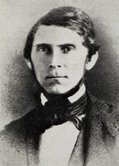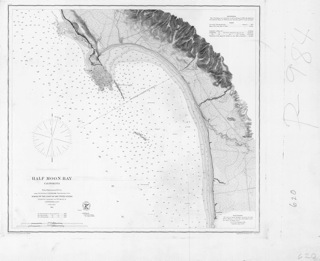Story by John Vonderlin
Email John ([email protected])
“The First to Die”

Hi June,
The editorial, “Let Us Have Light,” led me to professor Alexander Bache, the head of the Office of the Coast Survey, one of the predecessors to N.O.A.A. Thanks to their generous sharing of their Archives online, I captured a treasure trove of old Survey maps and logs that include the Coastside. I also became familiar with more of the details of the amazing events going on at the beginning of the Survey of the West Coast, and how important their work was to those who stayed to develop California after the Gold Rush fever played out. Before sharing the maps of the old Surveys, I’d like to salute the efforts of the early West Coast surveyors and relate the incredible problems they faced. A good place to start is the “First Man to Die” in the effort, Lt. William McArthur. This excerpt is from a N.O.A.A. tribute website and summarizes Lt. McArthur’s role in the beginning of this multi-year project. Though, his Surveys were few and barely touched the Coastside, his work sets the scene for George Davidson’s arrival a few years later. Enjoy. John P.S. For the rest of this story check out http://www.moc.noaa.gov/mt/mcarthur.htm
In July, 1848, the Coast Survey was directed to commence surveying the western coast. In October, McArthur received orders to make preparations for proceeding to San Francisco to take command of the hydrographic party of the EWING, a former revenue cutter that was transferred to the Survey. Lieutenant Washington H. Bartlett commanded the ship on its trip to the west coast via the Straits of Magellan. McArthur was to proceed to Panama and thence take whatever transportation was available to California. Unfortunately for McArthur, gold had just been discovered and the great migration of 49’ers had just begun. McArthur left the United States on March 17, 1849, and made it to Chagres on the Caribbean side of Panama in relative comfort; but from there to San Francisco, it was strictly improvisation. Upon arrival in Chagres, he found an overcrowded lawless town. Because he was a United States officer, he was made head of a vigilante committee and within 48 hours had restored order. He soon took a boat up the Chagres River and then went overland by mule train to the city of Panama. There was no transportation out and many of the travelers in the city were becoming sick with various tropical fevers. A delegation of gold seekers approached a local merchant who was using the Ship HUMBOLDT as a coal store ship. They bought the ship with funds from 400 passengers putting up $200 apiece and selected McArthur as commanding officer.
The HUMBOLDT left Panama on May 21, 1849, and took 46 days to reach Acapulco where supplies were taken on board as all on board were nearly famished. Cooking was done in a communal fifty-gallon pot with one meal served per day and coffee served in the morning and tea at night. Bedding was where one could find a place to lie down. The ship arrived in San Francisco on August 31. The EWING in the meantime had left the east coast on January 10, 1849, and arrived in San Francisco on August 1. Because of the possibility of crew desertions for either much higher pay on commercial vessels or leaving for the goldfields, Bartlett took the ship to Tomales Bay, north of San Francisco, on August 26. September 6 he returned to San Francisco and McArthur was installed as captain.
During September and October the EWING was engaged in surveys of San Francisco Bay, and it was by McArthur’s recommendation that the Government secured Mare Island for a naval base and shipyard. That winter McArthur sailed for Hawaii in order “to run away from the incessant rains which are said to prevail with winter.” When the ship returned to San Francisco, many crew enlistments had expired and it was not until April 3 that McArthur was able to sail for a reconnaissance of the northern coast. He was fairly discouraged by this time and wrote to a friend: “I have made up my mind to be disappointed with regard to the probability of our usefulness on this coast. Capt. Williams [Assistant J.S. Williams of the Coast Survey, who was in charge of the land party] has as yet done nothing and Heaven only knows when he may be able to proceed with his labors…. I feel confident that no work can go on at the present wages of the country as it would require the whole of the Coast Survey appropriation to keep a party together. Wages are still from five to twelve dollars per day, and if anything still rising as the mining season opens. I have written to the Professor [Alexander Dallas Bache] and laid my views before him.”
Like with most ships, once the EWING sailed, all the gloom and doom evaporated. On April 13, 1850, McArthur writes from Trinidad Bay,”I may safely say that the only happy days I have spent in the country have been spent since we started. I am at last at work and most usefully employed in making a reconnaissance of the Coast as we go up…. We have completed a very correct outline of the coast, its headlands, Bays, Rivers and indentations from San Francisco to this place, as well as carrying our soundings as we go….” Although not part of his crew, McArthur had the melancholy duty of retrieving the bodies of Lieutenants Richard Bache and Robert L. Browning who had volunteered to do a reconnaissance survey for the Navy in the vicinity of Point St. George, California. Richard Bache was a younger brother of Superintendent Bache. Four years earlier, Bache had another brother die in a hurricane while on Gulf Stream investigations for the Coast Survey.
In June, McArthur describes the scenery in the vicinity of the Columbia River as “beautiful and some places and some points of view the grandest that the eye ever beheld.” He had found time to speculate in real estate as he and two other officers had acquired homesteads in the Willamette Valley. He felt that if he could hold it for five years “it would be a fortune.” In late June and early July he went up to the Puget Sound area on the steamer CAROLINA. He described the waters of the sound as “a strange and peculiar anomaly. The deep blue sea runs up inland passing between straits but half a mile wide with a depth of over an hundred fathoms. Bays, Harbours, Inlets and Roads startle you at every turning forming a perfect labyrinth.” From the south end of Puget Sound, he traveled overland to the Cowlitz River and took a canoe to the mouth of the Columbia.
By the end of August, the EWING was back in San Francisco. McArthur experienced remarkable weather, both at the entrance to the Columbia River and on his trip back down the coast. In his words,”… We have been successful in surveying the mouth of the Columbia River and up the same as far as Astoria…. the dangers of navigation of this truly magnificent river have been vastly exaggerated. We have crossed the bar sometimes as many as ten times a day for weeks together…. On our way from the Columbia River we were successful enough to make a good reconnaissance of the whole coast from Cape Disappointment to this place and the limits of error may be estimated at one mile in longitude and an 1/2 mile in latitude. This I consider quite a triumph.”
While in San Francisco, McArthur was engaged in preparing for the next reconnaissance which was to extend south to San Diego. On November 21, he received the welcome news that he was to proceed to the east coast and take command of a steamship for west coast survey duty. Thus, with the prospect of seeing his wife and family a year earlier than he had anticipated, he booked passage on the steamship OREGON bound for Panama. The ship departed December 1, and, shortly after leaving San Francisco, McArthur suffered an acute attack of dysentery. He never recovered and died December 23 as the OREGON was entering the port of Panama.
William Pope McArthur was memorialized by a service at the Coast Survey office on February 8, 1851. At his service, Alexander Dallas Bache eulogized: ” The work which he accomplished will live forever. Surrounded by circumstances the most difficult, perhaps, which ever tried the constancy, the judgment, the resources of any hydrographer, he vanquished circumstances. His reconnaissance of the western coast, from Monterey to Columbia river, and his preliminary survey there, were made in spite of desertion and even mutiny–in despite of the inadequacy of means to meet the truly extraordinary circumstances of the country….”
[Image below: Map 1863]

